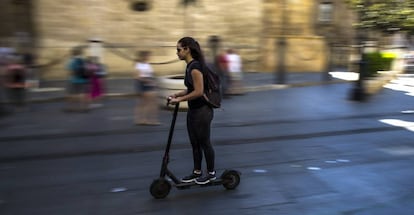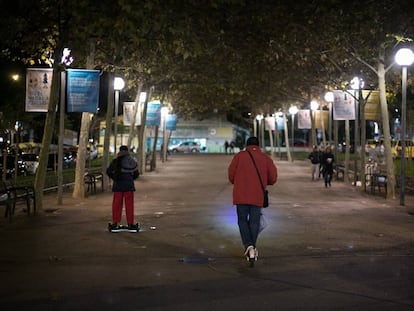Spain scrambles to regulate boom in electric scooters
While there are an estimated 100,000 personal mobility devices in the country, there are no national rules yet on where and how they can travel, leaving many cities in chaos

Marta González gets off the electric scooter she has ridden to the pharmacy where she works in the center of Seville, the capital of the southern Spanish region of Andalusia. “I started using it just over a year ago,” she says. “What with the heat here and the distances, it’s more practical than riding a bicycle, where you don’t stop sweating, or having to wait for the bus.”
González is one of an estimated 100,000 users of personal mobility devices (PMDs), a term that encompasses a wide variety of modes of transport that use electric motors and have become a common sight on the streets of Spain, blurring the traditional divide between pedestrian and motorized vehicles. But integrating these means of travel with pedestrians, bicycles and traditional traffic is not proving to be an easy task.
The same vehicle can be legal in one city because it has the license but not in another
Andrés Nadal, PMD user association Ampe
The varied technical details, aesthetics and concept of what constitutes a PMD make it difficult to see where they stand when it comes to municipal traffic regulations. The boom of these devices and PMD rental services has opened a legal vacuum that has forced some local councils to draw up regulations to address the current chaos. The Spanish traffic authority (DGT) passed legislation concerning PMDs in 2016, but recognizes it has become obsolete due to technological developments. More recently, the DGT drew up a draft royal decree to unite criteria and guide municipalities, which are waiting for this legislation in order to approve their own rules. The legislation should have taken effect in July, but the early general election on April 28 left it in limbo, with Spain yet to form a new government.
People who use PMDs are aware of the legal uncertainty, a fact that has reduced sales given there is no guarantee a purchase will comply with legal requirements, something recognized by Recambios Alamillo, an electric scooter store in Seville.
The current draft decree defines PMDs as vehicles for one individual with one or two wheels, exclusively driven by electric motors that have a top speed of 25 kilometers per hour. “By considering them vehicles, it will be against the law to drive on sidewalks, under the influence of alcohol or while using headphones,” says Jorge Ordás, deputy director of the DGT.
The DGT royal decree on personal mobility devices has been left in limbo
The draft legislation, according to Ordás, is a pioneering model in Europe, based on standards from the European Union.
“The article [of the law] is straightforward now because we wanted to give an immediate response to local city halls,” adds Ordás. “In a second phase we will cover issues such as the need for insurance, which is not currently mandatory, a minimum driving age and requirements concerning helmets and reflective clothing.”
The new legislation aims to simplify matters by dividing PMDs into two distinct groups. First, there are scooters with one or two wheels weighing 25 kilograms for one user. This category covers hoverboards, electric skateboards, electric scooters and electric unicycles. Then there are the Segways and electric scooters that can reach speeds of up to 30 kilometers per hour. “No PMD should be traveling at more than 25 kilometers per hour,” says Ordás.
All these vehicles should have a certificate that the manufacturer will have to provide. The royal decree does not make registration obligatory, though voluntary registration will help the DGT to centralize information. “But that doesn’t mean that the local councils won’t be able to have their own databases,” says Ordás. Although there are no official figures on the number of personal mobility devices in Spain, the DGT estimates the number is around 100,000.
During the previous administration, Seville’s City Hall unanimously passed the draft of the municipal by-law regulating the use of PMDs, but the municipal elections on May 26 have pushed back its implementation. Like Seville, the local governments in Granada, Murcia, Pamplona and Zaragoza are also waiting for the DGT decree to be approved.
Criticism from cyclists
The need for urgent regulation has prompted the local governments of Barcelona, Madrid, Málaga, Valencia and Mallorca to introduce their own rules. But the regulations on speed limits, vehicle power and accepted driving practices vary from city to city, a situation that has prompted complaints from associations of PMD users. “The same vehicle can be legal in one city because it has the license but not in another,” says Andrés Nadal, from the PMD user association, Ampe. “And in one city, a boy of 15 can ride it but not in another.”
It will be against the law to drive on sidewalks, under the influence of alcohol or while using headphones Jorge Ordás, deputy director of the DGT
PMDs improve mobility and sustainability in cities, providing a way to reduce traffic and pollution. But deciding where these devices are allowed to circulate is a source of conflict. Under the DGT draft decree, the devices would be banned from sidewalks and relegated to bicycle lanes, 30 kilometer-per-hour zones and places where the sidewalk and the road are not on separate levels, although the draft decree gives local councils the freedom to introduce further restrictions.
But cyclists’ associations are adamant that bicycle lanes should be exclusively for bicycles, either normal or electric, and any other PMD with the same features as an electric bicycle: no more than 250 watts of power and a maximum speed of 25 kilometers per hour.
Both PMD and cyclist associations are against the DGT ban on travel on interurban roads. “A 14-year-old can go on the highway on his bike but not on his scooter,” says Nadal. “The most basic PMDs can go 30 kilometers no problem, which means that they can be used for interurban routes. The DGT is not going to use them to be used for journeys on highways but surely it is all a question of technological innovation.”
Regulations on PMDs must consider how to stay ahead of the technological advances in the sector and address the new demands from society.
With reporting by Cristina Vázquez, Lucía Bohórquez, Virginia Vadillo and Nacho Sánchez.
English version by Heather Galloway.
Tu suscripción se está usando en otro dispositivo
¿Quieres añadir otro usuario a tu suscripción?
Si continúas leyendo en este dispositivo, no se podrá leer en el otro.
FlechaTu suscripción se está usando en otro dispositivo y solo puedes acceder a EL PAÍS desde un dispositivo a la vez.
Si quieres compartir tu cuenta, cambia tu suscripción a la modalidad Premium, así podrás añadir otro usuario. Cada uno accederá con su propia cuenta de email, lo que os permitirá personalizar vuestra experiencia en EL PAÍS.
¿Tienes una suscripción de empresa? Accede aquí para contratar más cuentas.
En el caso de no saber quién está usando tu cuenta, te recomendamos cambiar tu contraseña aquí.
Si decides continuar compartiendo tu cuenta, este mensaje se mostrará en tu dispositivo y en el de la otra persona que está usando tu cuenta de forma indefinida, afectando a tu experiencia de lectura. Puedes consultar aquí los términos y condiciones de la suscripción digital.
More information
Archived In
Últimas noticias
The operation in Venezuela to capture Maduro threatens to widen the cracks in the MAGA movement
Trump clarifies who is ultimately in charge in Venezuela: ‘Me’
Maduro pleads not guilty before the federal court in New York: ‘I am still the president of Venezuela’
A new test can detect Alzheimer’s from a finger prick
Most viewed
- Gilles Lipovetsky: ‘If you want to live better and fall in love, take Prozac, don’t look to philosophy’
- Alain Aspect, Nobel laureate in physics: ‘Einstein was so smart that he would have had to recognize quantum entanglement’
- Alvin Hellerstein, a 92-year-old judge appointed by Bill Clinton, to preside over Maduro’s trial in New York
- Why oil has been at the center of Venezuela-US conflicts for decades
- Cuba confirms death of 32 of its citizens in the US attack against Venezuela











































